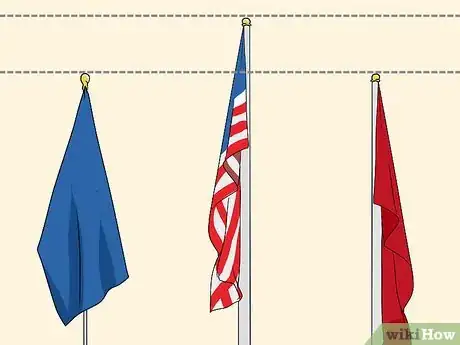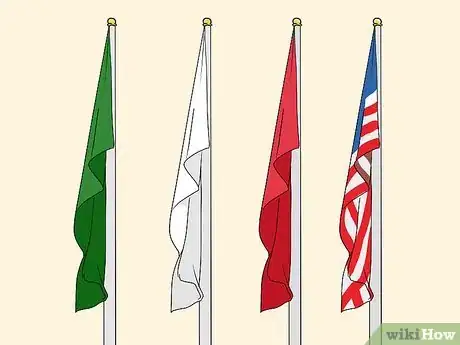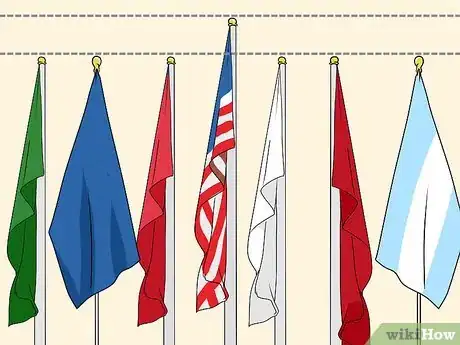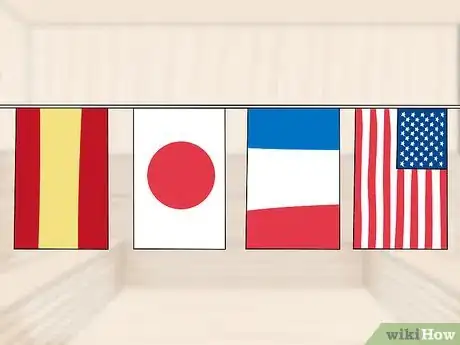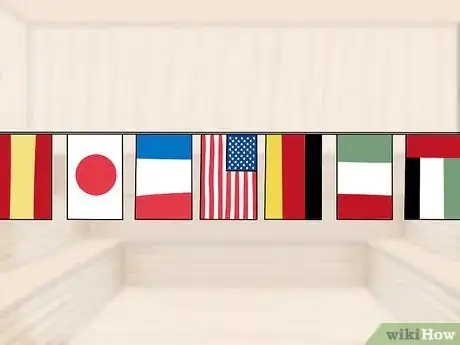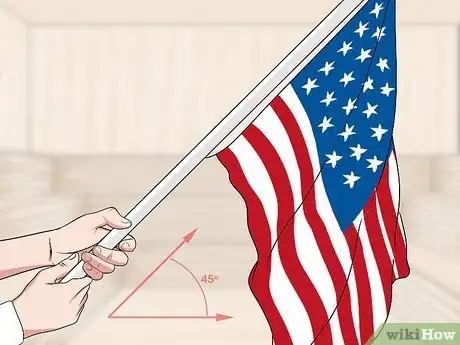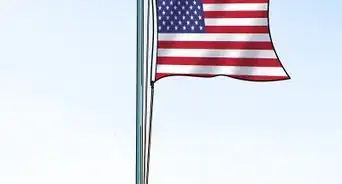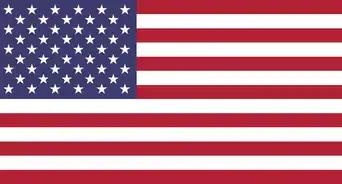This article was co-authored by wikiHow Staff. Our trained team of editors and researchers validate articles for accuracy and comprehensiveness. wikiHow's Content Management Team carefully monitors the work from our editorial staff to ensure that each article is backed by trusted research and meets our high quality standards.
This article has been viewed 41,326 times.
Learn more...
The US flag is considered a living symbol of the nation; therefore it should be treated and displayed with respect.[1] In general, the Federal Flag Code indicates that the US flag should be placed higher than all other national flags, and at the same level as international flags. It should also be placed on the flag line's far-right, in the position of honor. If you're displaying the flag in a procession or stationary display, you'll generally keep it on the far-right side, so that the largest number of people observe it on their left side.
Steps
Following General Display Guidelines
-
1Avoid displaying any other flag higher than the US flag. Keep the US flag at the same height as other international flags. Display it higher than state, city, or organizational flags.[2] The highest point is the place of honor, so be careful not to display another flag in this position within the US.
- Flying another flag higher than the US flag is considered a sign of disrespect.
-
2Place the US flag above other national flags that are on the same staff. If you choose to display flags of US states, cities, or local organization on the same staff as the US flag, place these below the US flag.[3] Keep the US flag at the top of the staff in the position of honor.
- The sole exception is that a church pennant may be displayed above the US flag during a church service conducted at sea by a Navy Chaplain.[4]
Advertisement -
3Keep the US flag to the far right in a row of flags displayed at the same height. International flags should be displayed at the same height as the US flag.[5] Among a row of international flags, place the US flag to the far right of all other flags.[6] Do this to keep the US flag in the place of honor within your display while respecting the other nations' flags.
- An onlooker standing across from the display should see the US flag on their own left side, and all other flags to their right.
- When arranging state, city, or organization flags along with the US flag, the US flag may be at the center, but it must be positioned higher than the others.
-
4Avoid displaying the US flag with flags of a larger size. When displaying the US flag along with international flags, make sure they're all about the same size. When flying the US flag above or alongside other national flags, make sure the US flag is the same size or larger than the others.[7]
- Relative flag sizes signify importance, which is why the US flag shouldn't appear smaller than other flags.
Arranging Stationary Displays
-
1Position the US flag to the right of a state flag when mounting crossed staffs. If you're mounting the US flag with a state flag in a crossed arrangement on a wall, keep the US flag to the right side and the state flag to the left, from the perspective of the flags themselves. When crossing the staffs, keep the staff of the US flag in front of the staff of the other flag. The US flag's staff should furthest from the wall.[8]
- Make sure that, to a viewer facing the display, the US flag appears to their own left.
- In this arrangement, both flags should cascade away from the central crossing point; they shouldn't overlap in the middle.
-
2Place the US flag at the centermost, highest point among a group of national flags. If you're displaying a series of flags in a row – whether outside on large flagpoles or indoors on upright staffs – designate the tallest staff or flagpole to the US flag. Place this one in the center of all the others.[9] Do this when flying the US flag with state, city, or organizational flags.
- This doesn't apply to times when you're displaying the US flag with international flags. These should be positioned at the same height, with the US flag on the right of the display.
-
3Position the US flag on a presenter's right-hand side. Do this when you're displaying the US flag with other flags near a podium within an auditorium or church. Keep the US flag on the podium's right side, and other flags on the podium's left side. From the flag's and presenter's perspectives, the US flag should be on the right.[10]
- As viewed by the audience, the US flag should appear to the left of the presenter or podium with the other flags to the right.
- State, city, and organizational flags should be on shorter staffs while international flags should be displayed at the same height.
-
4Keep flags of other nations on separate staffs at the same height. Choose international flags that are about the same size as the US flag you're displaying. Don't fly these flags on the same staff; make sure each has its own staff or flagpole.[11]
- It's improper to display the US flag at a higher level than another international flag during peacetime.
- Unless you're at the United Nations headquarters, refrain from flying the UN flag higher than the US flag.[12]
Displaying During a Procession
-
1Display the US flag to the right if it appears within a flag line. Place the US flag to the marching right, or the flag's own right, when it appears in a processed flag line[13] If other national flags appear in the same row, keep the US flag higher than the others.
- If necessary, dip the other flags at a 45-degree angle while you keep the US flag upright.[14]
- Display international flags at the same height as the US flag.
-
2Place the US flag at the front and center of the flag line to lead the way. Instead of placing the US flag at the right side of the flag line, you may position it ahead of all other flags in the procession.[15] Lead the flag line with the US flag for an especially patriotic effect. Try this approach during a parade celebrating a national holiday such as Independence Day or Memorial Day.
- Avoid processing with the US flag ahead of other international flags. Instead, keep them all in the same row.
-
3Avoid draping or dipping the US flag in a procession. Flagbearers holding the US flag should the flag upright. Refrain from dipping it, or lowering it to a 45-degree angle.[16] Flagbearers carrying state, city, and organizational flags may dip these flags as a sign of respect or honor. You should also avoid draping the flag over a vehicle or float. Instead, secure the flagstaff to the right side of the vehicle in an upright position.
- If you prefer a draped effect, use flag-inspired bunting. Arrange the bunting with the blue portion at the top and the red portion at the bottom.
- While being displayed, the US flag should never touch the ground or another object.
References
- ↑ https://www.senate.gov/reference/resources/pdf/RL30243.pdf
- ↑ https://www.senate.gov/reference/resources/pdf/RL30243.pdf
- ↑ https://www.va.gov/opa/publications/celebrate/flagdisplay.pdf
- ↑ https://www.legion.org/flag/code
- ↑ https://www.military.com/flag-day/flag-ettiquette-dos-and-donts.html
- ↑ https://www.senate.gov/reference/resources/pdf/RL30243.pdf
- ↑ https://www.sos.wa.gov/flag/other_flags.aspx
- ↑ https://www.va.gov/opa/publications/celebrate/flagdisplay.pdf
- ↑ https://www.va.gov/opa/publications/celebrate/flagdisplay.pdf
- ↑ https://www.legion.org/flag/code
- ↑ https://www.senate.gov/reference/resources/pdf/RL30243.pdf
- ↑ https://www.senate.gov/reference/resources/pdf/RL30243.pdf
- ↑ https://www.va.gov/opa/publications/celebrate/flagdisplay.pdf
- ↑ http://www.cbamarching.com/images/American_Flag_Etiquette.pdf
- ↑ https://www.va.gov/opa/publications/celebrate/flagdisplay.pdf
- ↑ http://www.cbamarching.com/images/American_Flag_Etiquette.pdf
